Fountain - Crystal Palace Gardens

This attractive fountain sits near the main entrance to Porto's Crystal Palace Gardens. Apparently there are four bronze statues around the sides of the fountain that represent the four seasons - although I'm not sure where we are supposed to be looking.
Crystal Palace Super Bock Arena - Porto
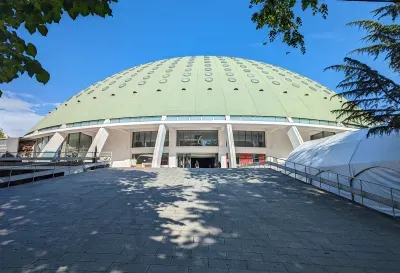
Porto's Super Bock Arena, or Pavilhão Rosa Mota to give it its more official name. It originally opened in 1954 and was named the Pavilhão dos Desportos (Sports Pavillion) but renamed in honour of the Olympic Marathon champion.
The site sits within the Crystal Palace gardens and is used for sporting and cultural events, as well as a congress centre.
Arrábida Bridge glimpse from Crystal Palace - Porto

The view from a leafy corner of the Crystal Palace Gardens which sit high above the Douro River in Porto. In the distance you can make out the huge concrete arch of the Ponte de Arrábida (Arrábida bridge) and beyond that, the Atlantic Ocean.
The gardens are a wonderful mix of the formal and semi-formal landscaped areas, including these terraces which tumble down the steep valley-side.
Chapel in Crystal Palace Gardens - Porto
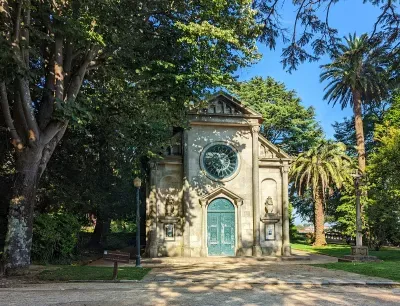
This pretty little chapel sits within the grounds of the Crystal Palace Gardens (Jardins do Palácio de Cristal) in Porto. The chapel actually predates the park and was built in honour of the "King of Sardinia", Carlos Alberto.
After being defeated by the Austrian army at the Battle of Novara, Alberto went into exile in Porto. He later died here and his half sister had the chapel built in his memory.
View from Crystal Palace Gardens - Porto

The view out over the Alfandega and River Douro from Porto's Crystal Palace gardens (Jardins do Palácio de Cristal). Set high above the riverside these landscaped gardens date back to Victorian times.
The name comes from the building of that name which was built here in 1865 to host the International Exhibition. Based on the London Crystal Palace the impressive building fell into disrepair over the years - as seems to happen in Porto! It was eventually demolished in 1951.
Castelo do Queijo detail - Porto
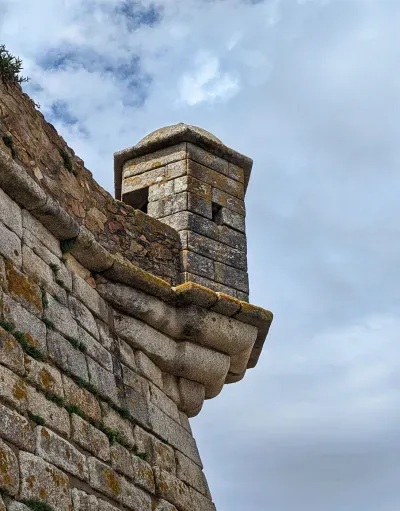
A closer look at one of the little watchtowers that project from the Castelo do Queijo on Porto's Atlantic seafront. Officially named the Forte de São Francisco Xavier the coastal fortress was built in the 1660s to defend against the Spanish. This corner of the fort overlooks the beach at Matosinhos.
As far as I know the fortress gets its name from the rock it was built on and has little to do with cheese. Whatever the case it was deemed fairly useless from the start as the area it defended was probably to exposed and rocky to land a fleet on anyway.
Old riverside crane - Fluvial, Porto
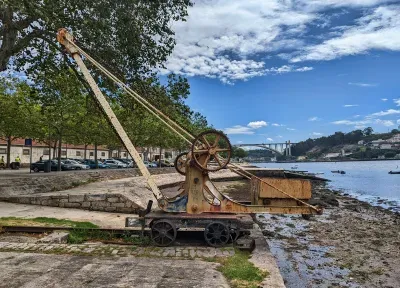
This little old crane sits at the end of some tracks on the banks of the River Douro at Fluvial. Not much loading and unloading goes on here these days but presumably it was a different story in the old days.
In the background is the impressive Arrabida bridge, once the largest concrete arch bridge in the world.
Traditional relief tiles

Traditional relief tiles with geometric floral pattern. Not sure if these qualify as azulejos - with the "azul" part meaning blue, but they are quite common, as is the flower motif on the tiles. One would imagine they were hand-painted when they were made, and looking closer it looks like they may have painted again in situ.
Pergola da Foz

The Pergola da Foz sits about halfway along Porto's seafront promenade overlooking Praia do Molhe. Designed by artist Antonio Enes Baganha, it was built in the 1930s when this part of Porto began to be gentrified.
This is a place of many moods; during the summer months the pergola is a popular spot to include in a seaside walk, whereas in the winter months the backdrop of an Atlantic storm can be fairly dramatic. Whatever the time of year it is a well-photographed icon of Foz do Douro.
Tosta Queijo
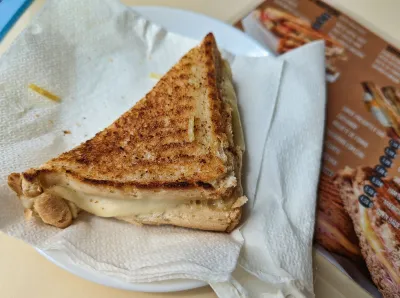
The classic Portuguese cafe snack - a tosta queijo - which translates as a cheese toastie. This is the more vegetarian version of the tosta mista, meaning "mixed toastie". The mix being cheese and ham...
This fine example was photographed (and consumed) in one of the beachfront cafes in Foz, Porto.